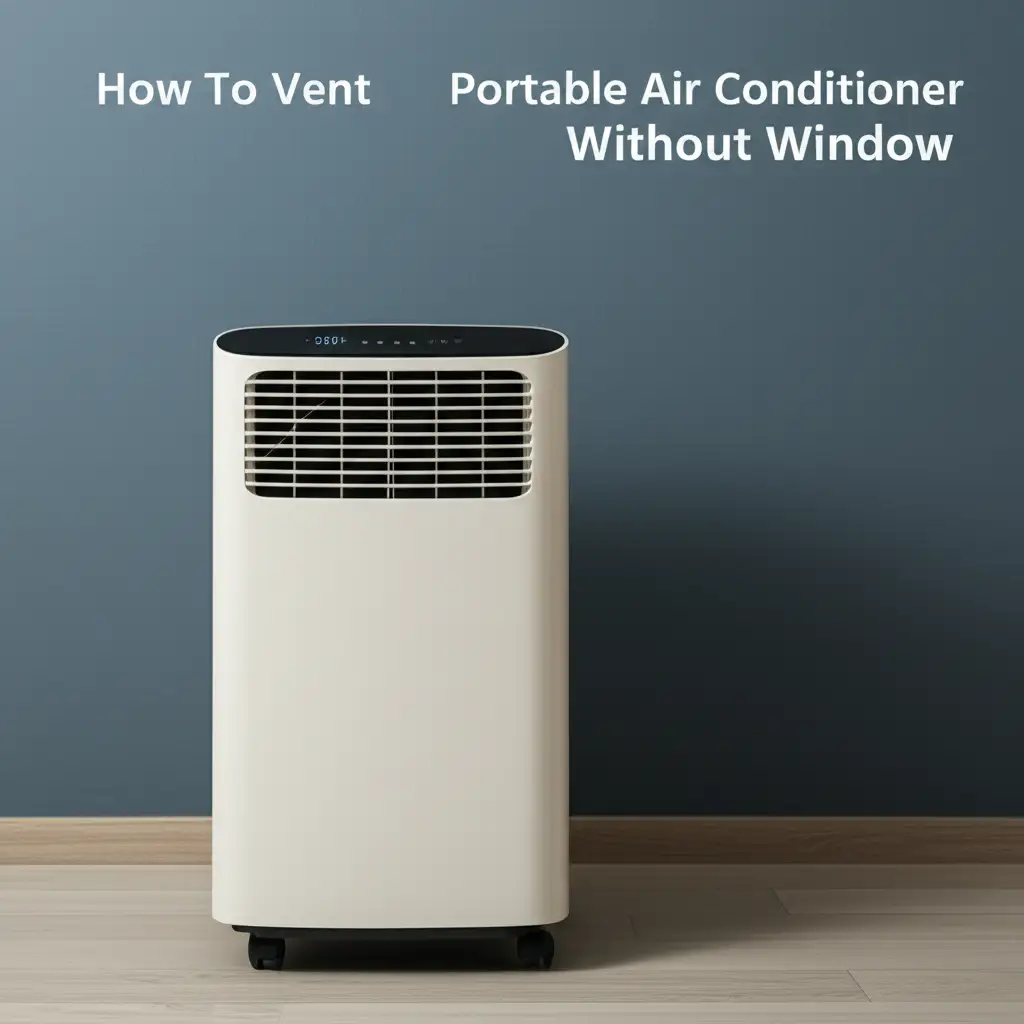· Davia Murnell · Home Comfort · 11 min read
How To Vent Portable Air Conditioner Without Window

How To Vent Portable Air Conditioner Without Window
When summer heat arrives, a portable air conditioner offers relief. However, venting it usually involves a window. What if your space lacks a suitable window, or you prefer not to use it? This guide explores effective methods to vent your portable air conditioner without a window. We will look at smart solutions. We will cover creative DIY approaches. You can keep your room cool and comfortable.
Takeaway
Vent a portable air conditioner without a window by using alternative exhaust points. Seal all gaps to ensure cool air stays in and hot air goes out.
Clear Answer
You can vent a portable air conditioner without a window by routing the exhaust hose through sliding doors, walls, ceilings, dryer vents, or even garage doors, ensuring all openings are properly sealed to prevent heat re-entry.
Understanding Portable AC Venting Needs
A portable air conditioner works by removing heat from a room. It does not just blow cool air around. It pulls warm air in, cools it, and then expels the hot air outside. This hot air must leave your living space. If the hot air stays inside, your room will not get cool. The portable AC comes with an exhaust hose for this purpose. This hose connects the unit to an outdoor vent point.
Most people use a window kit to vent this hot air. The kit provides a seal around the window opening. This keeps warm outside air from coming back in. Without proper venting, the AC unit will work against itself. It will blow out hot air that mixes with the newly cooled air. This makes the unit inefficient. It also wastes energy. This means your room stays warm. Proper venting is crucial for the unit to cool your space effectively. It helps your portable air conditioner perform at its best.
Venting Through Sliding Doors or Patio Doors
Sliding doors or patio doors offer a good alternative to windows for venting a portable air conditioner. These doors usually have tall, narrow openings. They are often found in living rooms or bedrooms. You can adapt the standard window kit to fit these doors. The kit includes a panel that slides into the door track. The exhaust hose then connects to this panel.
Sometimes, the standard kit is not long enough. You may need to buy an extension kit. You can also create a custom panel. Use materials like plywood, rigid foam insulation, or plexiglass. Measure the opening of your sliding door. Cut the material to fit this space. Make a hole in the panel for the exhaust hose. Seal any gaps around the panel and the doorframe. Use weatherstripping or foam tape. This prevents hot air from leaking back into the room. A well-sealed setup makes your portable AC more efficient. It ensures cool air stays inside.
Installing a Permanent Wall Vent
A permanent wall vent is a robust solution for venting a portable air conditioner without a window. This method involves creating an opening directly in an exterior wall. It is a more involved process than using a door. However, it offers a clean, fixed venting point. You will need to cut a hole in your wall. The hole must match the size of your AC’s exhaust hose. Then, install a vent cap on the outside of the wall. This cap prevents pests and water from entering.
Ducting connects the vent cap to the portable AC hose inside. This method requires careful planning. You must consider wall materials and local building codes. It is often best to consult a professional for installation. They ensure proper sealing and structural integrity. A wall vent provides a discreet and effective way to manage hot air. This setup offers a long-term solution. It keeps your space cool and comfortable. For detailed instructions, you can refer to our guide on how to install portable air conditioner vent in wall.
Utilizing a Garage or Adjacent Room
Venting your portable air conditioner into an adjacent room or a garage is another option. This method can work in specific situations. However, it requires careful thought. When venting into a garage, you transfer the hot air from your living space to the garage. This can make the garage very hot. Ensure the garage is not directly connected to the outside through large, open vents. If it is, the hot air will dissipate. If the garage is sealed, it will become a heat trap.
Venting into another indoor room is generally not recommended. This is because you are just moving hot air from one room to another. It does not remove heat from your home’s total air volume. This makes the AC less efficient for cooling your primary space. If you choose to vent into a garage, seal the connection point well. Use a panel similar to those for sliding doors. This keeps the living area cool. Consider the heat impact on the garage. For more details on this, you can check our article on how to vent portable air conditioner through garage door.
Connecting to a Dryer Vent
Connecting your portable air conditioner’s exhaust to an existing dryer vent might seem convenient. However, this method carries significant risks. Dryer vents are designed for lint and moisture removal. They are not made for continuous hot, dry air from an AC. A major risk is lint build-up. The AC exhaust can push lint back into the dryer, creating a fire hazard. It can also push lint into the exhaust fan, causing problems.
Another issue is backflow. Hot, moist air from the dryer can be pushed back into the room by the AC exhaust. This adds humidity. It also can create mold issues. Furthermore, the exhaust ports are often different sizes. You would need an adapter. This connection may not create a tight seal. This allows hot air to escape back into the room. For safety reasons, most experts advise against this method. It is best to avoid using a dryer vent for your portable AC.
Venting Through a Drop Ceiling or Floor
Venting through a drop ceiling or a floor can be a solution for certain spaces. This is common in commercial buildings. It can also work in basements with drop ceilings. A drop ceiling provides an accessible void above the main room. You can route the portable AC exhaust hose into this void. The heat then dissipates into the larger attic space or ventilation system. You will need to cut a hole in a ceiling tile. An appropriate vent grill then covers the hole.
Similarly, some homeowners might consider venting through the floor. This could involve routing the hose into a crawl space or basement. This method requires careful consideration of moisture and ventilation in the lower space. You must ensure proper airflow in the crawl space or basement to prevent humidity build-up. Both ceiling and floor venting typically require professional installation. This ensures safety and effectiveness. Proper sealing at the point of entry is essential. This prevents air leakage back into the cooled area.
Creative DIY Solutions and Adapters
When standard methods do not apply, creative DIY solutions can save the day. You can craft custom panels for unique openings. Think about skylights that tilt open. Consider pet doors, or even large mail slots. The key is to create a sealed barrier. Use materials like rigid foam insulation, plywood, or clear acrylic sheets. These materials are easy to cut. They can be sealed around the edges.
First, measure the opening you plan to use. Cut the material to fit snugly. Then, cut a hole in the panel. This hole needs to match the diameter of your portable AC’s exhaust hose. Use weatherstripping, foam tape, or duct tape to seal all gaps. This includes the edges of the panel and around the hose. You can even use plastic sheeting or heavy-duty tarps. Secure them with strong adhesive tape. This method is temporary. It can be very effective for odd-shaped spaces. The goal is to prevent hot air from entering. It also ensures efficient cooling.
Optimizing Portable AC Performance Without a Window
Maximizing your portable AC’s performance, especially when venting without a window, involves several key steps. First, ensure every single gap is sealed. Even small leaks allow hot air to seep back in. Use weatherstripping, caulk, or foam tape around your custom panels. Check where the hose connects to the AC unit and to the vent opening. A tight seal is critical for efficiency.
Next, insulate the exhaust hose. The hose itself gets very hot. This heat radiates back into the room. Wrap the hose with insulating material. This can be foil bubble insulation or foam pipe insulation. This simple step can significantly reduce heat gain. Keep the exhaust hose as short and straight as possible. Longer or kinked hoses restrict airflow. This makes the AC work harder. Regularly clean your portable AC’s filters. Dirty filters reduce airflow. They also decrease cooling power. A clean unit runs more efficiently. For instructions on how to clean your unit, refer to our guide on how to clean portable air conditioner. Also, ensure the water tank is drained as needed. This prevents water build-up. If your unit collects water, see our article on how to clean portable air conditioner water tank. These steps boost your AC’s cooling power. They ensure comfort in your space.
FAQ Section
Can I vent a portable AC into the attic?
Venting a portable AC into an attic is generally not recommended. Attics often lack proper ventilation. This can lead to heat and moisture buildup. The hot, humid air from the AC could become trapped. This may cause mold, mildew, or damage to insulation. It also makes the attic extremely hot. This can increase your home’s overall cooling load. Always vent hot air directly outside.
Is it safe to vent into a fireplace chimney?
Venting a portable AC into a fireplace chimney is unsafe and ineffective. Chimneys are for high-temperature exhaust from fires. AC exhaust is not hot enough to create an updraft in a chimney. The exhaust would likely just settle or circulate back into the room. Soot and creosote can also get into your AC unit. This creates a fire hazard. It can also damage the AC unit.
How far can the exhaust hose extend?
Keep the portable AC exhaust hose as short as possible. Manufacturers usually provide a hose length optimized for the unit’s performance. Extending the hose too far increases back pressure. It makes the unit work harder. It also causes more heat to radiate from the hose itself. This lowers cooling efficiency. Stick to the provided hose length or only slightly extend it if necessary.
Does a portable AC work without venting?
No, a portable air conditioner does not work effectively without venting. Without venting, the unit simply cools the air and then re-releases the extracted heat back into the same room. This creates a cycle where the room temperature will not drop. The unit will run constantly without achieving its purpose. Proper venting is crucial for cooling any space.
Can I vent into another room?
Venting a portable AC into another room is not a true cooling solution for your home. It simply transfers the heat from one room to another. The heat is still inside your living space. This makes the entire home warmer. For effective cooling, the hot air must leave the house completely. Venting into an unconditioned space like a garage might work, but not into another living area.
What if I have a casement window?
If you have a casement window, a standard window kit for portable ACs will not work. These windows swing open, not slide. You will need a custom solution. You can create a rigid panel from plexiglass or plywood. Cut it to fit the casement window opening. Cut a hole in the panel for the exhaust hose. Then, seal it tightly. This creates a secure venting point.
Conclusion
Venting a portable air conditioner without a window might seem challenging, but it is achievable. We explored several effective methods to get the hot air out of your space. Whether you use a sliding door, install a wall vent, or get creative with DIY solutions, the key is to ensure proper sealing. Every method requires careful attention to detail. This prevents hot air from returning indoors. By following these guidelines, you can keep your room cool and comfortable. Your portable air conditioner will operate efficiently. Take action today. Choose the best venting solution for your home. Enjoy a cooler, more comfortable living environment this summer.





